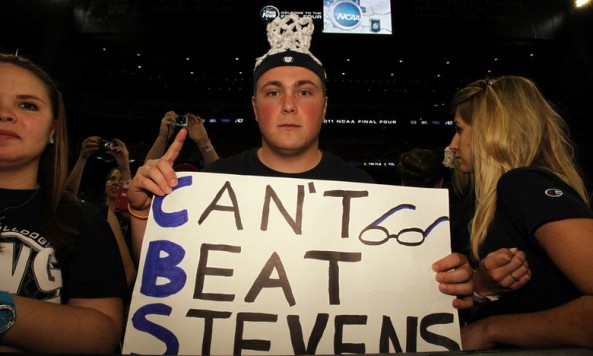I don’t know of any other mid-major team that, even after losing 54.3 percent of its minutes and 64.1 percent of its scoring in the offseason, could still be picked No. 1 in its conference preseason poll (in a fairly stacked conference) and No. 2 overall in the preseason College Insider Mid-Major Top 25. But Butler, despite losing its top two possessors from last season’s second-straight run to the NCAA Tournament championship game, Matt Howard and Shelvin Mack, did exactly that. People believed in Brad Stevens no matter who he had on the floor.
Now the Bulldogs are 4-6, unranked in the College Insider Mid-Major Top 25 and reeling from their third straight loss — to 109th ranked (by Pomeroy) Ball State. Reality has set in in Indianapolis: Even Brad Stevens has rebuilding years.
With resume-breaking losses to Evansville, Ball State and Valparaiso already on the books and 10-1 Cleveland State’s rise to the top of the Horizon League, it appears Butler might not even make it into the NCAA tournament for the first time since 2006.
So what’s wrong with the current team? What happened?
Namely, the offense is broken. The Bulldogs are scoring 0.98 points per possession (under Pomeroy’s adjusted efficiencies), which is sixth among Horizon League teams, and 208th nationally. Shots aren’t falling from anywhere on the court, signaled by the team’s 323rd-ranked eFG% (41.7 percent). Butler is ranked 251st or worse in every shooting component: from inside the arc (251), outside the arc (335) and at the stripe (275). Compare this to last season when the ‘Dogs averaged 1.11 ppp with a 49.8 eFG% fueled by Matt Howard (53.8 percent) and Shelvin Mack (49.6 percent).
Shots aren’t falling, because this young Butler offense is getting rushed by opponents, and committing on bad looks. In their three wins over Division-I competition the Bulldogs averaged 60.3 possessions (61, 61 and 59), and shot 40.4 percent from the floor. In their six losses the Dawgs averaged 69.0 possessions (adjusted for overtime periods) and shot just 36.6 percent.
Stevens is aware of the problem, of course.
“I think that we’ve got some guys with the ability to make shots, and, certainly, they need to step up and do that,” Stevens told the Journal Gazette. “But the bottom line is that job becomes easier if you execute and you take good (shots).”
Point guard Ron Nored, the team’s only senior member and the only starting remnant of last season’s tournament run, is a very low volume shooter (he takes a shot in just 11.1 percent of his possessions), while sophomore two-guard Chrishawn Hopkins is the team’s current go-to guy. Hopkins leads in both possessions and shots while stringing along a less than ho-hum 41.1 percent eFG%. Sophomore starting power forward Khyle Marshall has the team’s best shooting stroke (57.2 percent eFG%), but he does his thing in the paint. The Dawgs simply lack an outside threat to keep smart defenses honest.
Until Butler can find that deep threat they’ll continue to tangle with tough defenses in the post. Senior Arkansas transfer Rotnei Clarke changes everything though. When he’s eligible to take the floor for the Dawgs next season the defense will finally be balanced. Clarke led all SEC shooters from beyond the arc last season, draining 43.8 percent from three. Butler’s current volume three-point shooter, senior winger Chase Stigall is logging 31.0 percent from trey-range.
There are also some reassuring signs of life from Butler’s freshman. Sophomore 6-4 forward Roosevelt Jones has worked his way into the starting lineup and is averaging an offensive board in 13.9 percent of his chances. Freshman Kameron Woods is pulling down a team-best defensive board in 22.9 percent of his chances.
But in the meantime, things are about to get way uglier in Indy. The Bulldogs face Purdue, Gonzaga and Stanford this next week before heading into conference play.























